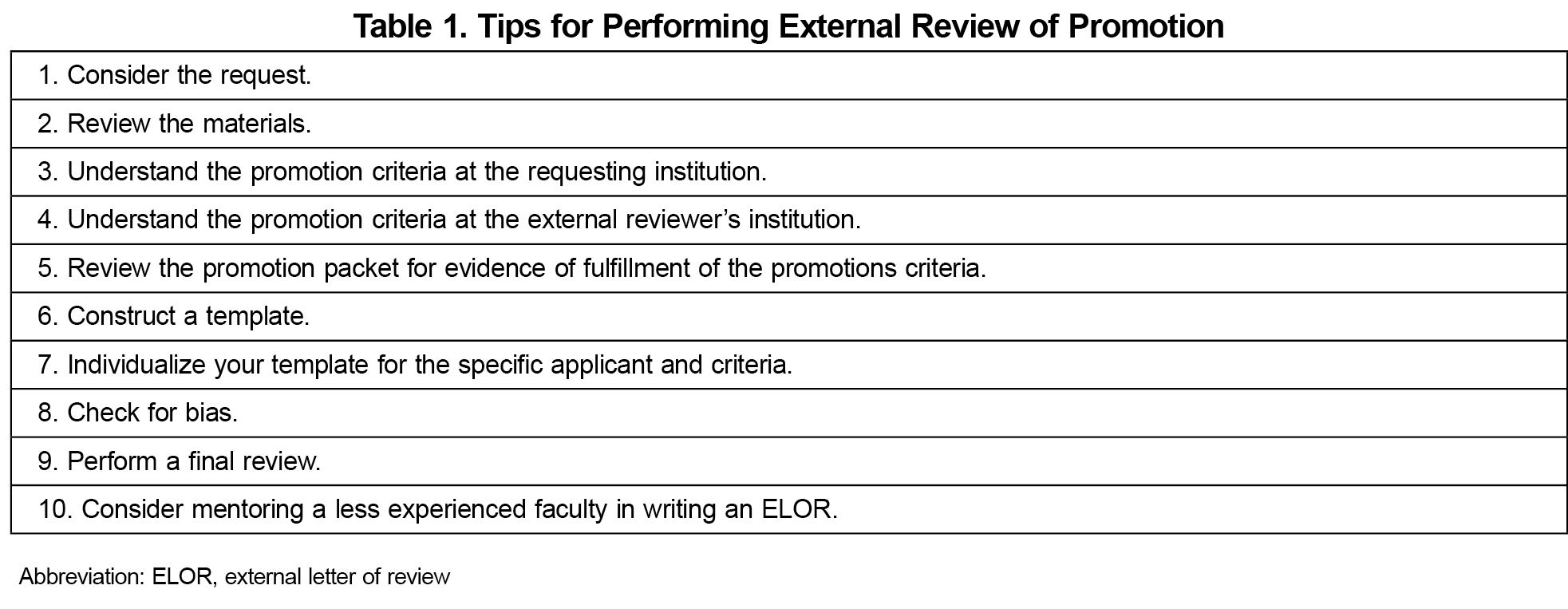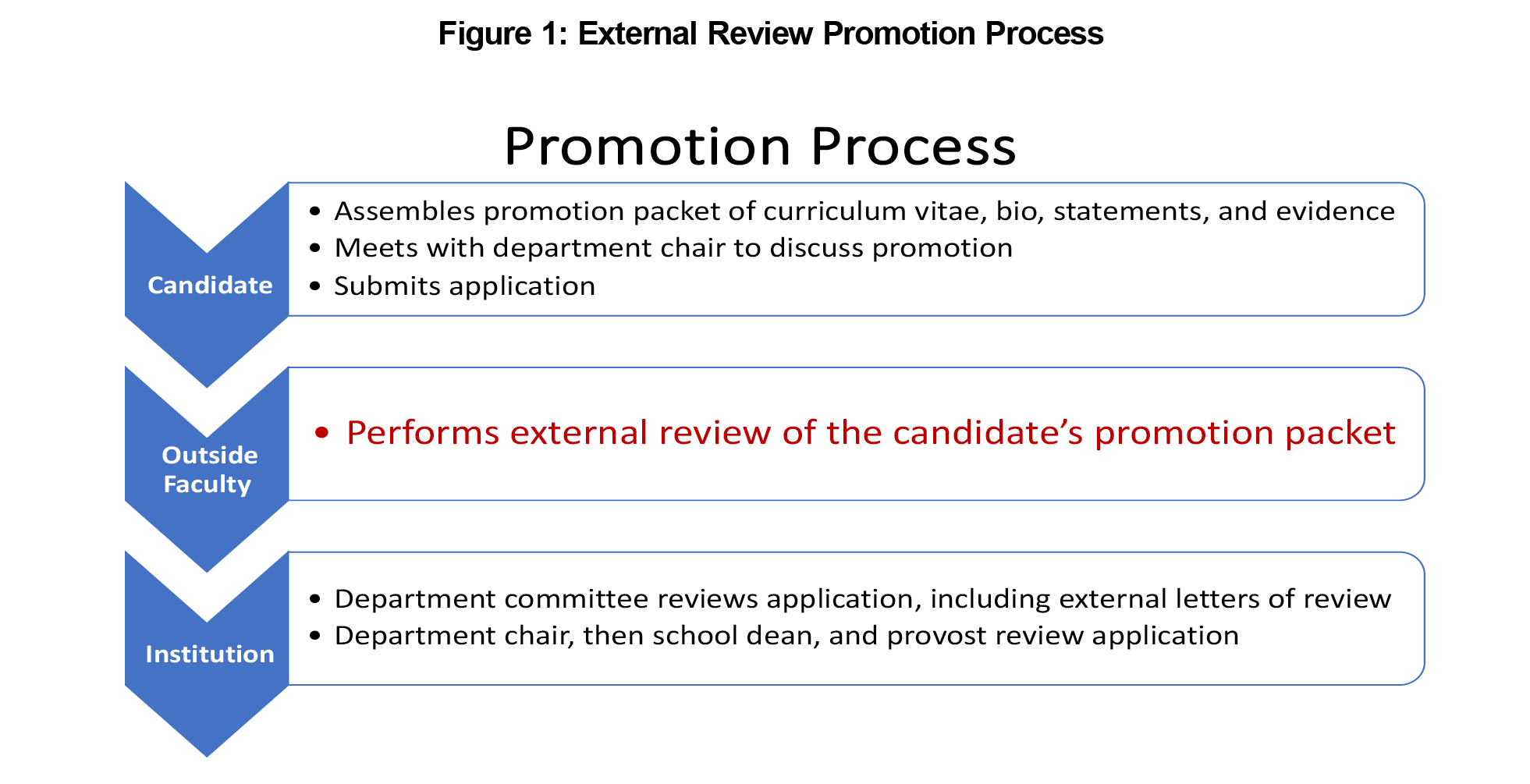Academic promotion represents a key achievement for medical educators, impacting their self-satisfaction, reputation, salary, and opportunities. External letters of review (ELORs) play a crucial role in promotion applications. Though the important skill of performing external reviews benefits academia,1 faculty are rarely trained to complete ELORs.2 Some academic organizations have created letter writers’ bureaus that train and list willing reviewers.3-5 Understanding ELOR best practices improves the skill and quality of letters. In this article, we provide an approach to writing ELORs to facilitate attaining high quality. Table 1 and Figure 1 outline the letter writing and promotion processes, respectively
PROFESSIONAL DEVELOPMENT PERSPECTIVE
Writing an External Letter of Review for Promotion
Suzanne Minor, MD | Sarah E. Stumbar, MD, MPH | Joanna Drowos, DO, MBA | Jennifer Hartmark-Hill, MD | Victoria Hayes, MD | Jeanne Cawse-Lucas, MD | Parvathi Perumareddi, DO
PRiMER. 2023;7:34.
Published: 10/10/2023 | DOI: 10.22454/PRiMER.2023.447836
Academic promotion, representing achievement of a level of distinction in one’s body of work, is an honorable accomplishment in a faculty member’s career. External letters of review written by faculty at higher ranks are a critical component of the promotion portfolio. We discuss key considerations for writing external letters. These considerations can be used to mentor this skill for less experienced letter writers. We also highlight how professional societies can aid faculty in developing and strengthening writing and mentoring capabilities for this vital task.
Consider the Request
Before responding to an ELOR inquiry, you should reflect on your time, skill, and relationship to the person requesting the letter, as well as assess the individual’s portfolio. Inquiries should include the candidate’s curriculum vitae (CV), statements showing their qualifications, and institutional promotions criteria. Faculty are encouraged to accept ELOR requests because this professional service is essential for the family medicine community to govern itself.
We recommend that you and the applicant not have a close relationship (eg, mentoring, coauthoring, or collaborating)6; yet anecdotally, this does occur. If a potential bias exists, such as a history of working at the same institution or friendship, you should decline the request.6-7 When in doubt, clarify the requirements with the institution.
Accepting or rejecting an ELOR invitation based on a portfolio assessment may be controversial. Refereed letters tend to be affirmatively written, which may lessen their value in the promotion process.8 Some faculty choose to write only affirmative ELORs because unfavorable letters may have possible legal risk, cause tension, or harm a colleague’s reputation, career, or personal life.7
A timely response (2–3 days) to a request is warranted because declining requires the department to seek another reviewer within the promotion timeline.6 When declining, you should include a clear explanation, such as time demands, insufficient materials provided, or conflict of interest.6 If accepting the request, you should schedule time to write the letter well before the deadline; well-written letters take hours to complete.
Review the Materials
Carefully review the materials received to determine how the candidate meets the promotion criteria. Sample materials may include the institutional criteria; the applicant’s CV, teaching philosophy, and portfolio with evaluation and supporting data; letters of support; and assignment letters denoting effort. If any materials are missing, you should contact the department rather than the applicant.
The letter of request should provide guidance on the level of evidence needed to meet each criterion and specific questions to address. When you are asked to assess national or international impact, ideally the request provides examples, such as references to articles in Scopus, that you can use to evaluate the applicant’s work.
Understand the Promotion Criteria at the Requesting Institution
Understanding the varying promotion criteria between institutions and tracks is important.9,10 An effective letter considers these guidelines and provides the committee with the outside referee’s opinion.9
The department is interested in the reviewer’s assessment of the candidate’s achievements, including perceptions of the candidate’s work at the local, regional, national, and international levels.10 Your assessment should focus on the impact of the applicant’s achievements, such as contributions to a new national standard or curricular innovation, rather than listing the candidate’s activities.2 Useful ELORs include examples of how a candidate met or exceeded promotional criteria. Some institutions provide descriptions of activities meeting the criteria, which you can use to guide the letter’s content.9
Understand the Promotion Criteria at the External Reviewer’s Institution
Often, the reviewer is asked to include a statement applying the institution's promotion criteria to the applicant’s portfolio. Being aware of how the promotion criteria at your institution differ from the requesting institution’s criteria can help you mitigate bias.
Review the Promotion Packet for Evidence of Fulfillment of the Promotions Criteria
You should list evidence from the promotion packet with respect to criteria and qualifications.6 Outlining and using the promotion criteria as the letter’s framework may be useful in documenting the applicant’s accomplishments and impact by category. Consider leadership roles, curricular impact, evaluation data, honors, major service commitments, publications, grants, and invited presentations as potential achievements.
Construct a Template
Constructing a letter template fosters a systematic, holistic, efficient approach. Begin with your qualifications for writing the promotions letter, including your academic rank, relevant positions or titles, number of years in your current role(s), any prior knowledge of the candidate, and whether you are waiving the ELOR review. The letter body consists of an outline of promotion criteria, description of materials reviewed, and comparison of the criteria to the applicant’s qualifications.6,9 For each criterion, consider the quantity, quality, and impact of the applicant’s work as well as their experience interacting with their work, which you may learn by observing them speak or reading their papers. In the last paragraph of the letter, provide your recommendation for or against promotion.
Individualize Your Template for the Specific Applicant and Criteria
Tailor the template for each applicant, including the organization and trajectory of the applicant’s work experience as detailed in their CV and statements. Importantly, because letters may be read by people outside of your specialty or discipline, articulate the appropriate context and do not assume commonality of understanding and experiences.9 Because reviewers of the ELOR may be unfamiliar with family medicine, your letter should explain the narrative’s themes and the significance and impact of projects, committees, collaborative work, roles, and publications. For instance, you may note that Academic Medicine is the foremost academic medicine publication or that the Society of Teachers of Family Medicine (STFM) is the premier academic family medicine organization. Your letter may need to further describe the prominence of certain STFM roles and committee work.
When addressing your own qualifications for writing the letter, include information about your professional background relevant to the applicant. The body of your letter should detail your work in reviewing the material; the applicant’s qualifications, including headings specific to the applicant’s promotion criteria; evidence of fulfillment of the promotions criteria from the applicant’s CV and statements; impact of experiences, scholarly presentations, and publications as compared to institutional criteria; and a recommendation regarding promotion (including, if asked, whether the applicant would be promoted at your institution).
Check for Bias
The best practice for avoiding contributing to bias is a systematic approach. Reflect on whether you would have used the same wording if the applicant were of a different race or gender (eg, adjectives for interpersonal skills and work ethic). Focus on comparing the applicant with the requirements of the job rather than on personal qualities.
Consider checking the letter with an online bias calculator. Ask yourself whether any stereotypically feminine descriptors are relevant to institutional promotions criteria and whether a well-rounded assessment is presented. Use appropriate titles and surnames.
Perform a Final Review
Conduct a final review by assessing overall content, clarity, and tone. Consider the letter’s audience, including the candidate and nonmedical parties. The letter should be fair, comprehensive, and illustrate the candidate’s qualifications, considering quantity, quality, balance, and impact. Proofread for errors; submit on time.
Consider Mentoring a Less Experienced Faculty in Writing an ELOR
If you are an experienced letter writer receiving a letter request, consider proactively mentoring less experienced faculty to help cultivate this skill and help them to understand how they need to present their own promotion portfolio. Bear in mind that the academic rank of the letter writer needs to exceed or equal the rank to which the candidate is seeking promotion. Academic conferences may facilitate group mentoring.
This article provides a framework for writing ELORs, toward the goal of expanding ELOR capacity in academic medicine. Academic societies are encouraged to support letter writer bureaus and offer trainings. Departments should provide feedback to reviewers about the promotion outcome, closing the loop on the process, recognizing effort, and providing ongoing faculty development.
Acknowledgments
The authors thank the Society of Teachers of Family Medicine for creating an environment and network that facilitated this incredible collaboration.
Presentations:
Content from this article was presented at the Society of Teachers of Family Medicine Annual Spring Conference, April 29–May 3, 2023, Tampa, Florida.
References
- Sparrow B. Concluding thoughts: spotlight on promotion letters. PS Polit Sci Polit. 2019;52(2):344-346. doi:10.1017/S1049096518002202
- Agarwal V, Mullins ME, Mainiero MB, Suh RD, Chetlen AL, Lewis PJ. The ADVICER template for faculty reviewer letters for promotion and appointment.Acad Radiol. 2022;29(9):1,413-1,416.
- Oh L, Linden JA, Zeidan A, et al. Overcoming barriers to promotion for women and underrepresented in medicine faculty in academic emergency medicine. J Am Coll Emerg Physicians Open. 2021;2(6):e12552. doi:10.1002/emp2.12552
- Friedman KA. Garnering referees for women for academic promotion. Acad Med. 2021;96(7):935. doi:10.1097/ACM.0000000000004081
- Society for Academic Emergency Medicine. Academy for Women in Academic Emergency Medicine. Accessed September 1, 2022. https://community.saem.org/communities/community-home?CommunityKey=58595efd-f39b-45ac-93b4-398646d11f4f
- Misra J, Lundquist J. Letters of assessment. Inside Higher Ed. July 13, 2016. Accessed September 1, 2022. https://www.insidehighered.com/advice/2016/07/14/advice-writing-letters-assessing-other-faculty-tenure-and-promotion-essay
- Goldman E. Writing tenure-review letters. Inside Higher Ed. January 18, 2017. Accessed September 1, 2022. https://www.insidehighered.com/advice/2017/01/19/advice-how-write-effective-tenure-review-letters
- Weyland K. Promotion letters: current problems and a reform proposal. PS Polit Sci Polit. 2019;52(2):332-336. doi:10.1017/S1049096518002147
- Roberts L, ed. The Academic Medicine Handbook: A Guide to Achievement and Fulfillment for Academic Faculty.Springer; 2013. doi:10.1007/978-1-4614-5693-3
- Papaconstantinou HT, Lairmore TC. Academic appointment and the process of promotion and tenure. Clin Colon Rectal Surg. 2006;19(3):143-147. doi:10.1055/s-2006-948026
Lead Author
Suzanne Minor, MD
Affiliations: Florida International University Herbert Wertheim College of Medicine, University Park, FL
Co-Authors
Sarah E. Stumbar, MD, MPH - Florida International University Herbert Wertheim College of Medicine, University Park, FL
Joanna Drowos, DO, MBA - Charles E. Schmidt College of Medicine, Florida Atlantic University, Boca Raton, FL
Jennifer Hartmark-Hill, MD - University of Arizona College of Medicine-Phoenix, Phoenix, AZ
Victoria Hayes, MD - Maine Medical Center, Portland, ME
Jeanne Cawse-Lucas, MD - University of Washington, Seattle, WA
Parvathi Perumareddi, DO - Charles E. Schmidt College of Medicine, Florida Atlantic University, Boca Raton, FL
Corresponding Author
Suzanne Minor, MD
Correspondence: Florida International University Herbert Wertheim College of Medicine, University Park, FL
Email: seminor@fiu.edu
Fetching other articles... 
Loading the comment form... 
Submitting your comment... 




There are no comments for this article.